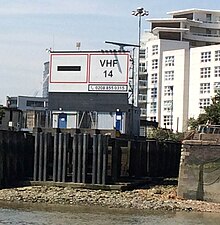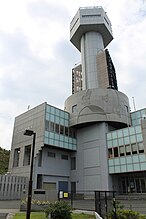
A coast guard or coastguard is a maritime security organization of a particular country. The term embraces wide range of responsibilities in different countries, from being a heavily armed military force with customs and security duties to being a volunteer organization tasked with search and rescue without law enforcement authority. In most countries, a typical coast guard's functions are distinct from those of the navy and the transit police, while in certain countries they have similarities to both.
The International Association of Marine Aids to Navigation and Lighthouse Authorities (IALA), previously known as International Association of Lighthouse Authorities, is an association founded in 1957 to collect and provide nautical expertise and advice. IALA is also known by its French name of Association Internationale de Signalisation Maritime (AISM).

The Canadian Coast Guard is the coast guard of Canada. Formed in 1962, the coast guard is tasked with marine search and rescue (SAR), communication, navigation, and transportation issues in Canadian waters, such as navigation aids and icebreaking, marine pollution response, and support for other Canadian government initiatives. The Coast Guard operates 119 vessels of varying sizes and 23 helicopters, along with a variety of smaller craft. The CCG is headquartered in Ottawa, Ontario, and is a special operating agency within Fisheries and Oceans Canada.
The International Regulations for Preventing Collisions at Sea 1972 also known as Collision Regulations (COLREGs) are published by the International Maritime Organization (IMO) and set out, among other things, the "rules of the road" or navigation rules to be followed by ships and other vessels at sea to prevent collisions between two or more vessels. COLREGs can also refer to the specific political line that divides inland waterways, which are subject to their own navigation rules, and coastal waterways which are subject to international navigation rules. They are derived from a multilateral treaty called the Convention on the International Regulations for Preventing Collisions at Sea, also known as Collision Regulations of 1960.

The Port of Hong Kong located by the South China Sea, is a deepwater seaport dominated by trade in containerised manufactured products, and to a lesser extent raw materials and passengers. A key factor in the economic development of Hong Kong, the natural shelter and deep waters of Victoria Harbour provide ideal conditions for berthing and the handling of all types of vessels. It is one of the busiest ports in the world, in the three categories of shipping movements, cargo handled and passengers carried. This makes Hong Kong a Large-Port Metropolis.

The automatic identification system (AIS) is an automatic tracking system that uses transceivers on ships and is used by vessel traffic services (VTS). When satellites are used to receive AIS signatures, the term Satellite-AIS (S-AIS) is used. AIS information supplements marine radar, which continues to be the primary method of collision avoidance for water transport. Although technically and operationally distinct, the ADS-B system is analogous to AIS and performs a similar function for aircraft.

The Airports Authority of India (AAI) is a statutory body under the ownership of the Ministry of Civil Aviation, Government of India. It is responsible for creating, upgrading, maintaining, and managing civil aviation infrastructure in India. It provides Communication Navigation Surveillance/Air Traffic Management (CNS/ATM) services over the Indian airspace and adjoining oceanic areas. AAI currently manages a total of 137 airports, including 34 international airports, 10 Customs Airports, 81 domestic airports, and 23 Civil enclaves at Defense airfields. AAI also has ground installations at all airports and 25 other locations to ensure the safety of aircraft operations. AAI covers all major air routes over the Indian landmass via 29 Radar installations at 11 locations along with 700 VOR/DVOR installations co-located with Distance Measuring Equipment (DME). 52 runways are provided with Instrument landing system (ILS) installations with Night Landing Facilities at most of these airports and an Automatic Message Switching System at 15 Airports.
The United States Coast Guard is the coastal defense, search and rescue, and maritime law enforcement branch of the United States Armed Forces and is one of the country's eight uniformed services. It carries out three basic roles, which are further subdivided into eleven statutory missions. The three roles are:

A navigational aid (NAVAID), also known as aid to navigation (ATON), is any sort of signal, markers or guidance equipment which aids the traveler in navigation, usually nautical or aviation travel. Common types of such aids include lighthouses, buoys, fog signals, and day beacons.
Sector Commander is the position title of the commanding officer of a United States Coast Guard Sector, usually of the rank of Captain (O-6). The Sector Commander's second-in-command is the Deputy Sector Commander. Also reporting directly to the Sector Commander are the Command Master Chief (CMC), the Senior Reserve Officer, and the Sector's Auxiliary Coordinator.
A Sector is a shore-based operational unit of the United States Coast Guard. Each Sector is responsible for the execution of all Coast Guard missions within its Area of Responsibility (AOR), with operational support from Coast Guard Cutters and Air Stations. Subordinate commands within a Sector typically include Stations and Aids-to-Navigation (ATON) Teams. Some Sector commands also have subordinate units such as Sector Field Offices and Marine Safety Units that are responsible for mission execution in parts of the Sector's AOR. There are 37 sectors within the Coast Guard.
Monitoring, control and surveillance (MCS), in the context of fisheries, is defined by the Food and Agriculture Organization (FAO) of the United Nations as a broadening of traditional enforcing national rules over fishing, to the support of the broader problem of fisheries management.
NSW Maritime, the trading name of Maritime Authority of New South Wales, was an agency of the Government of New South Wales, Australia responsible for marine safety, regulation of commercial and recreational boating and oversight of port operations. The Authority had responsibility for marine incident investigation, including the causes of incidents involving shipping and commercial vessels and breaches of State or Commonwealth navigation laws. Incidents involving Sydney Ferries vessels are examined by the Office of Transport Safety Investigations, which is also responsible for investigations into incidents involving publicly owned rail and bus transport. The Authority was also responsible for property management of submerged lands in Sydney Harbour, Newcastle Harbour, Botany Bay and Port Kembla, and for providing strategic advice on ports and maritime matters to the NSW Government.

A traffic separation scheme or TSS is a maritime traffic-management route-system ruled by the International Maritime Organization or IMO. It consists of two (outer) lines, two lanes, and a separation zone. The traffic-lanes indicate the general direction of the ships in that lane; ships navigating within a lane all sail in the same direction or they cross the lane in an angle as close to 90 degrees as possible.

The Estonian Maritime Administration was a governmental agency that operated within the area of government of the Ministry of Economic Affairs and Communications. It was mainly tasked with implementing national economic policies and maritime safety in Estonian territorial and navigable inland waters. In 2021, the organization was superseded by the Estonian Transport Administration.
e-Navigation is a strategy developed by the International Maritime Organization (IMO), a UN specialized agency, to bring about increased safety of navigation in commercial shipping through better organization of data on ships and on shore, and better data exchange and communication between ships and the ship and shore. The concept was launched when maritime authorities from seven nations requested the IMO's Maritime Safety Committee to add the development of an e-navigation strategy to the work programs of the IMO's NAV and COMSAR sub-committees. Working groups in three sub-committees and an intersessional correspondence group, led by Norway, has subsequently developed a Strategy Implementation Plan (SIP). Member states of IMO and a number of Intergovernmental and non-governmental organisations have contributed to the work, including the International Hydrographic Organization (IHO), Comité International Radio-Maritime (CIRM), the International Association of Lighthouse Authorities (IALA), the International Chamber of Shipping (ICS), the Baltic and International Maritime Council (BIMCO) and the International Electrotechnical Commission (IEC)
Sea traffic management (STM) is a methodology, developed by the Swedish Maritime Administration MonaLisa project, endorsed by the European Commission, sought to define a set of systems and procedures to guide and monitor sea traffic in a manner similar to air traffic management.
The Directorate General of Coastal Safety has been established by the Turkish Republic Council Of Ministers’ decision on 12 May 1997 as a General Directorate and State owned Organization. The mission of the foundation is to assist and improve the safety of navigation in Turkish Waters. The organization’s core competences are:

Navielektro /nɑvielektro/ is a privately owned Finnish company specialized in development and maintenance of situational awareness, surveillance and communication systems for both civilian and military purposes. Navielektro develops, manufactures and provides maintenance for a range of various radar and related sensors and communication equipment.
Autonomous and Remote Navigation Trial Project is the trial of maritime autonomous surface ships (MASS) in commercial operations hold within 2020 in three different sea water areas of Russia.














